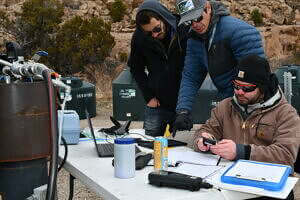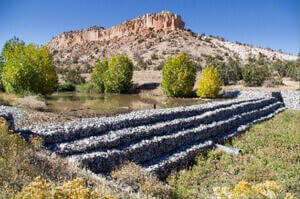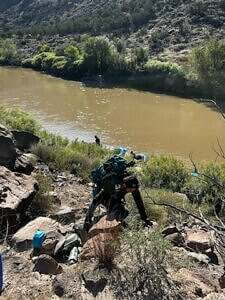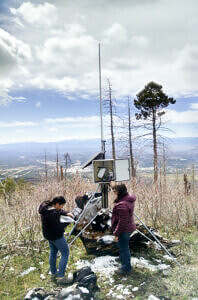LOS ALAMOS, N.M. — Newport News Nuclear BWXT Los Alamos (N3B) crews collected more than 8,670 soil, sediment, surface water and groundwater samples in 2023. Results from the samples gathered help guide legacy waste cleanup at Los Alamos National Laboratory (LANL).
“Our robust sampling program helps verify the effectiveness of our legacy waste cleanup operations at LANL,” said Amanda White, director of N3B’s Environmental Remediation Water Program. “The focus and commitment to protecting water supplies is of paramount importance to Department of Energy (DOE) Environmental Management Los Alamos Field Office (EM-LA) and N3B.”
The U.S. Environmental Protection Agency, state of New Mexico and DOE provide regulatory oversight for surface water, stormwater and groundwater, including water that surfaces through springs.
The surface and groundwater programs are part of N3B’s mission to clean up legacy waste at LANL. In fact, protecting water and the environment is the major reason for cleaning up LANL legacy waste. Those efforts focus on remediating contamination from legacy operations across mesas, canyons and drainages throughout LANL.
Additionally, N3B manages a substantial network of sampling, inspection, controls and treatments across LANL to help ensure the cleanup of legacy waste is effective. Some examples include low-head weirs, berms, detention basins and grade-control structures.
The numbers are impressive. In 2023, N3B collected 4,000 water samples and 4,670 soil and sediment samples, conducted 5,013 stormwater control inspections, and treated nearly 23 million gallons of groundwater to remove hexavalent chromium.
“Since some of our sampling is of stormwater and sediment mobilized in stormwater, the challenge is never knowing when, where and how much it is going to rain,” N3B Surface Water and Stormwater Manager Karly Rodriguez said.
N3B Groundwater Monitoring Manager Keith McIntyre added that access to many of the sampling sites is also an issue.
“Thunderstorms, snow and ice, washed out roads, as well as operational access because of sensitive work, can make collecting samples a challenge,” he said.
Due to Los Alamos’ rugged terrain and the remoteness of some sampling sites, using the latest technology is critical to meeting the commitment to protect water supplies.
“To help meet that commitment, we now have about 250 locations where we use automated stormwater samplers programmed to collect samples during storm events. Since stormflow is high intensity and of a short duration, automated samplers are critical to collecting samples,” Rodriguez said.
White added, “Protecting the environment, especially water, is our priority in cleaning up legacy waste at LANL and ensuring water quality objectives are met.”
###
About N3B:
Newport News Nuclear BWXT Los Alamos (N3B) is a limited liability company owned by HII Nuclear and BWX Technologies. N3B manages the $2.1 billion, 10-year Los Alamos Legacy Cleanup Contract for the U.S. Department of Energy Environmental Management Los Alamos Field Office.
Photos:

Photo filename: groundwater sampling.jpg
Caption: Groundwater monitoring studies began in 1945 at Los Alamos National Laboratory (LANL). Today, workers collect nearly 2,300 groundwater samples annually. The groundwater samples are collected from a network of more than 200 monitoring wells located on LANL, Pueblo de San Ildefonso, Los Alamos County and Santa Fe County property. The sampling helps ensure water drawn for human consumption meets all federal and state drinking water standards.

Photo filename: engineered structure.jpg
Caption: The low-head weir pictured is one of many storm water controls that help prevent contaminated sediment from being transported downstream. Other types of controls include berms, detention basins and grade-control structures. All are included in an annual maintenance and inspection program.

Photo filename: WhiteRockClimb.jpg
Caption: The safest way to collect annual groundwater, surface water and sediment samples near the point of entry into the Rio Grande is from the river side of the massive White Rock Canyon. Water access for the sampling crews, equipment and samples is much safer than traversing the steep, rugged and isolated canyon walls.

Photo filename: Radiotelemetry.jpg
Caption: Newport News Nuclear BWXT Los Alamos is upgrading its older radio telemetry system, pictured, to a more reliable satellite-based telemetry system. The new system will allow expansion of automated sample collection and data transfer capabilities in remote and hard-to-reach areas.
